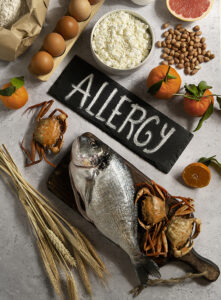 by Lance Redwantz, MS, RD, Nutrition Program Director
by Lance Redwantz, MS, RD, Nutrition Program Director
Typically, our immune system is engaged to protect us against an invading pathogen; however, that is not the case when discussing an allergy. Food allergies are medical conditions involving the triggering of the immune system upon exposure to a harmless protein found in various foods. Food allergies are not the same as a food intolerance as the food intolerance fails to involve the immune system, histamine, and specific types of white blood cells upon exposure. One in 10 adults and 1 in 13 children suffer from food allergies in the United States. In total 32 million Americans suffer from food allergies. Reactions to an allergen, the substance causing the response, can range from mild to severe. Mild symptoms include items such as hives, a scratchy throat, and watery eyes. Whereas the most severe symptoms result in anaphylaxis, which causes an interruption in breathing, decreased blood pressure due to elevated histamine levels, and loss of consciousness. Due to the lack of a cure for food allergies, prevention is essential.
The nine major allergies include dairy, eggs, soy, peanuts, tree nuts, fish, shellfish, wheat, and sesame. The addition of sesame as an allergen occurred as of Jan. 1st, 2023 by the Food and Drug Administration (F.D.A.). The F.D.A. monitors food manufacturers via inspections and testing to ensure the manufacturer is in compliance with laws and regulations surrounding food safety, food labeling, and risk analysis regarding allergens.
Dining with a Plan
Dining out when you suffer from a food allergy can be very difficult; however, that doesn’t mean it isn’t possible. There are tips and tricks to navigating food allergies when you are out and about in your community.
- Food Contact Surfaces Matter! The act of cross contamination may occur when an allergen comes into contact with the same surface as an allergen free food. For this reason, individuals with a food allergy should avoid salad bars, buffets, and sharing utensils with others. You never know when something else has been spilled, splashed, or dipped into a food which may contaminate it.
- Communication is key. Do not hesitate to ask your host, wait staff, or a manager about the contents of a dish. Inform staff of your food allergy. If staff are uncertain if they can accommodate you, move along as the risk is too great.
- Deep frying danger – Remember that multiple food items may be placed in the same oil used to fry your food. This is a prime example of cross contamination. Unless the establishment you are at has a dedicated fryer for your specific allergen, fried foods will not be safe to eat.
- Avoid baked goods and desserts. Commercial bakery items such as premade desserts, breads, rolls, and more, are a high risk for cross contamination. Items not made in house at a restaurant, limit the ability of staff to assess if a food item is safe for your consumption. The same may occur with ice cream. Dessert is a wonderful way to finish out a meal; however, for those suffering from an allergy, it is a dish best prepared at home in a controlled environment.References
FoodAllergy.org and www.fda.gov/food/food-labeling-nutrition/food-allergies

